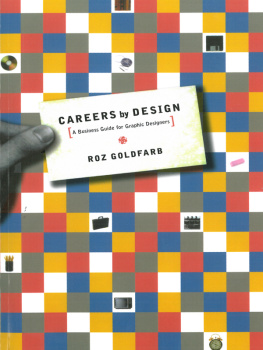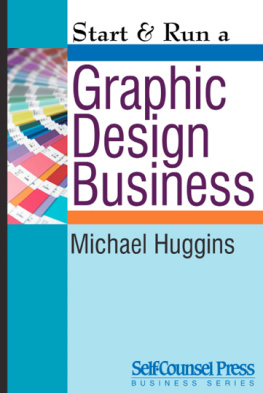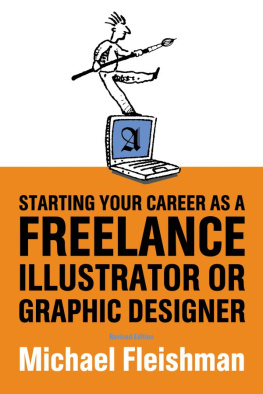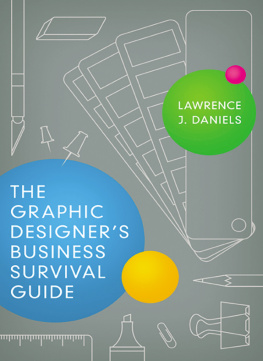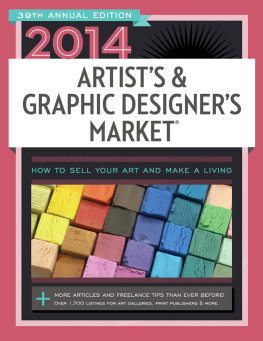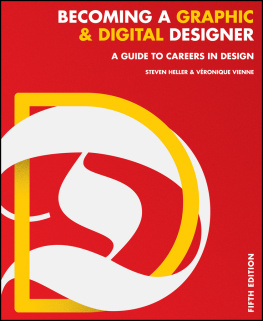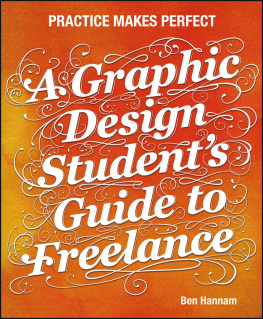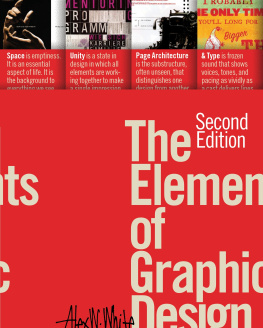THIRD EDITION

2001 Roz Goldfarb
All rights reserved. Copyright under Berne Copyright Convention, Universal Copyright Convention, and Pan-American Copyright Convention. No part of this book may be reproduced, stored in a retrieval system, or transmitted in any form, or by any means, electronic, mechanical, photocopying, recording, or otherwise, without prior permission of the publisher.
08 07 06 05 04 7 6 5 4 3 2
Copublished with The Graphic Artists Guild
Published by Allworth Press
An imprint of Allworth Communications
10 East 23rd Street, New York, NY 10010
Cover design by Jennifer Moore, James Victore, Inc.
Page design by Jennifer Moore
Page composition by CA Brandes
Printed in Canada
Library of Congress Cataloging-in-Publication Data:
Goldfarb, Roz.
Careers by design: a business guide for graphic designers/by Roz Goldfarb.3rd ed.
p.cm.
Includes bibliographical references and index.
ISBN 1-58115-205-1
1. Commercial Art. 2. Vocational guidanceUnited States. I. Title.
NC1001.G65 2002
745.4'023'73dc21
2001006181
T he world of design is many things to many people, and efforts to characterize that world and the attributes of those who inhabit it have often been attempted. If anything, design is an emotional terrain. Those people who are creative, or who work with designers, find themselves within a landscape of professionals incredibly dedicated to the craft of design in its various applications, and committed to it in a way that often defies logic. Successful designers share a passion for design that is an essential component of their lives. This is true of most serious creative people practicing in any of the arts, but if this book has only one message, it is that design is a business, driven by many motivating business factors. Its applications are very practical. Therefore, todays successful designers require a whole other set of skills to survive in this complicated technological and global business climate. Keeping issues in context, it should be remembered that designers have been accused of not being able to see the big picture, of being too focused on the detail of the design, of being so engrossed in the design as to forget the business requirements of the projects. Often, designers have been accused of being an introverted clique, talking to themselves and not communicating with the outside world.
However, the reality is that the designers role is highly extroverted, for the graphic designer holds a unique position in our expanding world of communications. While the field of design has grown and matured substantially in the United States, the general public is only beginning to recognize its impact on our everyday existence. Simply put, everything we wear, touch, read in traditional or interactive media, ride in, or live in has been created by a designer. Our newspapers, magazines, and books; our activities on the Internet; e-commerce, research, and entertainment; our household appliances and automobiles; the packages that cover every object imaginable and entice us to buy; the graphic images, logotypes, and signs in stores and restaurants, as well as their identity, menus, and, sometimes, even their names; the computers, cell phones, PDAs, and their interface screens; the amusement parks we take our children to; the famous cartoon characters we become attached to, and the licensed products we buy with their logos or images; the shapes of cosmetic jars, bottles, lipsticks, and their packaging; the gift wrap and cards for presents; the incalculable numbers of brochures, annual reports, and corporate literatureall have been developed or designed by graphic, architectural, and industrial designers. The list is endless.
This book is all about the business of design. It is a guide through the boundaries of design, how these companies are structured, the roles people play, and what business or communications problems they are required to solve. It is also about how to find ones way, build a career, and get a job.
There is so little information about the business of design that this book became an instant success when it was first published in 1992. As we approach the third revised edition, it confirms the need for periodic changes, for this is a business always in transition. Tracking transition is always difficult, for the question of how to define a new direction versus identifying something that is perhaps only trendy is very tricky. And in this fast-paced world, one always has the sinking feeling that the minute something is put to print, it is obsolete. Nonetheless, this guide has proven very valuable for those who are entering this arena from colleges, or those who are transitioning from other fields, or those who just want to learn more about the world of design. These pages are also peppered with the comments of many professionals whose day-to-day challenges require knowledge and insight to help guide the way. Their contributions are extremely valuable as they give a special sort of timely reality check.
Careers by Design also looks at the historythe development of the business with perhaps a sense of where it is going. In that light, all my colleagues agree. The business has changed; its different. Casual conversations over lunch or chance meetings on the street all focus on this point. Whats new? one asks. Everything. The business surely is different... its just not the same, is the answer, said sometimes wistfully, sometimes in frustration. These remarks were written for the revised edition of this book in 1995 and now, at the beginning of 2001, they are still true, but the difference at the beginning of this millennium is not just in computerization or a sentimental wish for the way things were. The differences refer to a profound shift as to what design can mean, being defined as both a tangible designed object as well as a process of thinking. Technology has force-fed new ways of thinking about systems and structure, and has created the ability to produce at speeds not always healthy for considered thought. In fact, if there is any common complaint, it is the insatiable request for speed. Shorten timelines and the concept of 24/7 has become the bane of many designers existence.
As said, Careers by Design was originally published in 1992. The World Wide Web only came into practical usage in 1994. In 2001, we cannot imagine life without the resources of the Internet, our fast computers, the frustrations in search of broadband access, our PDAs, cell phones, and the obvious advent of wireless technology which is so advanced in countries other than the United States. The state of business today is digital, global, infinitely more complicated, sophisticated, and, without question, exciting. Our society has changed at a pace unparalleled in history and the graphic designers role is not only integrally connected but often on the cutting edge of these continuing changes. Nonetheless, many of the basics of design fundamentals do not change. It is important to keep perspective, for the utilization of systems and technology do not replace the fundamental requirements of design, composition, typography, taste, and talent. And technology has given us an enhanced understanding of the importance of content as well as the necessity of the art of communication. What better an environment could a designer ask for? This world of content, visual, and systems solutions for communication is an environment that requires design on every front. The nature of analytical thinking and design-based problem solving is a clear requirement for solutions.

